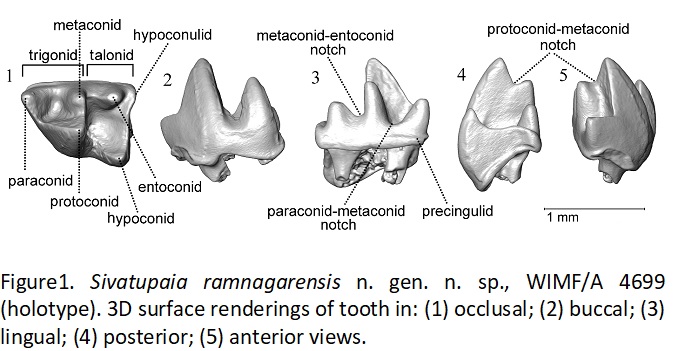- Six Reasons To Bring Millets To The Market!
- Hong Kong Court Makes Landmark Ruling Protecting Transgender Rights
- Substrate Promiscuity Of Fungi Generated Enzyme Laccase Shows Potential In Degrading Industrial Dye Effluents
- Union Minister Of Rural Development Holds A Meeting On ‘Cactus Plantation And Its Economic Usage’
- Ministry Of Tribal Affairs Organised One Day Mega Health Camp ‘Abua Bugin Hodmo-Our Better Health’ At Saraikela Kharsawan, Jharkhand
- Blue Flag Standards For Beaches In The Country
- India-Namibia Sign An MoU On Wildlife Conservation And Sustainable Biodiversity Utilization
- Hydrophobic Ingredients, In Combination With Obsolete Antibiotics, Can Counter Multidrug-Resistant Bacteria
- Promoting Cultivation Of Kala Namak Paddy
New genus of treeshrew from Ramnagar in Jammu and Kashmir can provide a precise age estimate for the locality
Posted by: 2022-06-29 18:46:34 ,By Admin

Scientists have spotted fossils of a small mammal resembling squirrels called treeshrew belonging to a new genus and species from Ramnagar in Jammu and Kashmir.
This treeshrew currently represents the oldest record of fossil tupaiids in the Siwaliks, extending their time range by 2.5–4.0 Million Years in the region and can help provide a more precise age estimate for this Ramnagar locality lying in the Udhampur District (UT-Jammu & Kashmir).
Siwalik sediments document the evolution of many mammalian groups from the middle Miocene through Pleistocene including treeshrews, hedgehogs, and other small mammals. Treeshrews, in particular, are very rare elements of the fossil record, with only a few species known throughout the entire Cenozoic era.
Scientists from the Wadia Institute of Himalayan Geology (WIHG), an autonomous institute of Department of Science and Technology (DST) found fossils of the new genus and species of treeshrew (known as Sivatupaia ramnagarensis n. gen. n. sp) from the middle Miocene (extends from about 23.03 to 5.333 million years ago) site of Ramnagar in Jammu and Kashmir.
Dietary analyses suggest that the new tupaiid was probably adapted for a less mechanically challenging or more fruit eating diet compared to other extant and fossil tupaiids. In addition, new hedgehog and rodent specimens have been described from this same fossil locality. The murine rodents are of particular importance, because different species and dental features are well-known to be time sensitive, as has been documented throughout a continuous, time-controlled Siwalik sequence on the Potwar Plateau of Pakistan. Therefore, the identification of these time sensitive dental features and species in the current collection help to provide a more precise age estimate for this Ramnagar locality as between 12.7-11.6 Million Years.
This work was carried out by Dr. Ramesh Kumar Sehgal (leading author), Dr. Ningthoujam Premjit Singh (corresponding author) and Mr. Abhishek Pratap Singh from Wadia Institute of Himalayan Geology, Dehradun, India in association with researches from Panjab University Chandigarh (Dr. Rajeev Patnaik); Hunter College of the City University of New York, USA (Dr. Christopher C. Gilbert); University of Southern California, Los Angeles (Dr. Biren A. Patel); Arizona State University, USA (Dr. Christopher J. Campisano); American Museum of Natural History, USA (Dr. Keegan R. Selig). It was recently published in the Journal of Paleontology. The newly described specimens are housed in the repository of Wadia Institute.
The finding was published in the Journal of Paleontology https://doi.org/10.1017/jpa.2022.41
Read more: Click Here
You may like similar news

NASA's scary visualisation shows how greenhouse gases are altering oceans. Watch
"With 70% of the planet covered by water, the seas are important drivers of Earth’s global cli...
.jpg)
Google techie says getting rejected for promotion was ‘blessing in disguise': 'I knew I needed to show…'
Google techie said that soon she moved to Google Fiber where she was rejected for a promotion.A Goog...
.jpg)
Meta says Israeli firm posted 'deceptive' AI-generated content on Gaza war: 'Posed as Jews, African Americans...'
Meta identifies an Israeli political marketing firm likely using AI to spread misinformation on Inst...
.jpg)
Brutal heatwave grips Delhi, Rajasthan, other states; IMD issues ‘red’ alert | 10 hottest Indian cities
The IMD has issued a ‘red’ alert of severe heatwave conditions for Delhi, Rajasthan, Har...
.jpg)
Dombivli blasts: Boiler was unregistered, used highly reactive peroxides | 10 updates
Dombivli boiler blasts: The explosions shattered glass panes and damaged rooftops within a 4-km radi...









